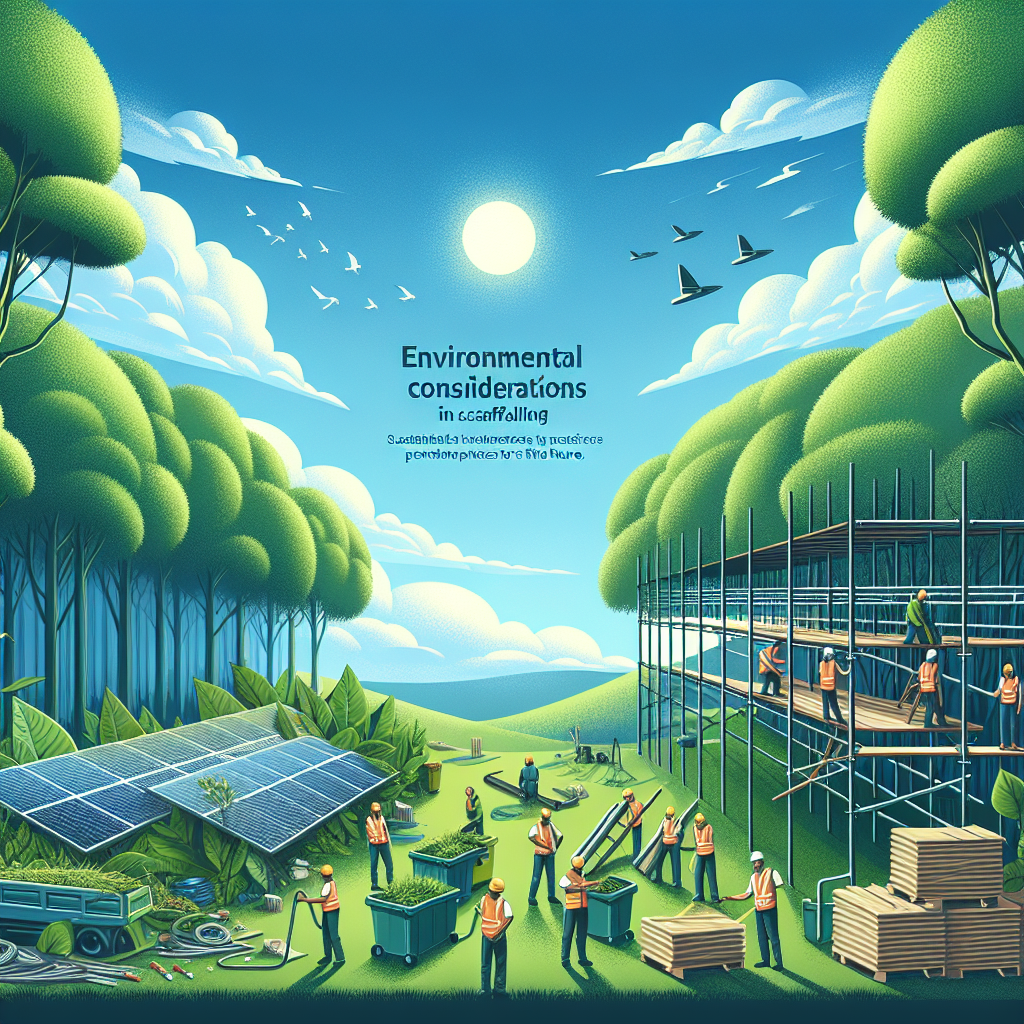
Introduction
As cities grow taller and construction projects become more complex, the scaffolding industry stands at a pivotal crossroads. Traditional scaffolding practices often neglect the environmental toll they take, contributing to waste, pollution, and resource depletion. With growing global awareness of climate change and sustainability, the time has come to integrate Environmental Considerations in Scaffolding: Sustainable Practices for the Future into every phase of construction. This shift not only helps in conserving our planet but also promotes a more resilient and responsible construction sector.
In this article, we will delve deeply into sustainable scaffolding methods, examining real-world case studies, innovative materials, and practices that reduce the environmental impact of scaffolding. Let’s embark on this journey to uncover the ultimate strategies that scaffolding companies can adopt for a greener tomorrow.
The Importance of Sustainable Scaffolding
Understanding the Environmental Impact
Construction activities are inherently resource-intensive, involving large quantities of materials, energy, and water. Scaffolding, while essential for safety and access, often contributes significantly to environmental degradation through:
- Material Waste: A typical scaffold setup can leave behind surplus materials, which often end up in landfills.
- Energy Consumption: The energy required for manufacturing, transporting, and installing scaffolding is substantial.
- Pollution: Fuel-operated machinery and transport can lead to air and noise pollution.
The Need for Sustainable Practices
In light of these challenges, the construction sector must pivot towards incorporating Environmental Considerations in Scaffolding: Sustainable Practices for the Future. Sustainable scaffolding not only reduces ecological footprints but also enhances efficiency and safety on construction sites.
Sustainable Materials for Scaffolding
Utilizing Recycled and Renewed Resources
One pivotal way to minimize environmental harm is by using scaffolding materials that are either recycled or sustainably sourced. Here are some enlightening examples:
-
Aluminum Scaffolds: These are preferred due to their high recyclability. When a project concludes, aluminum scaffolding can be melted down and repurposed without a loss in quality.
- Bamboo Scaffolding: Utilized in many Asian countries, bamboo is a renewable resource that provides an eco-friendly alternative to traditional scaffolding materials.
Innovative and Eco-Friendly Materials
Emerging technologies are paving the way for the use of innovative materials in scaffolding. For instance:
-
Modular Scaffolding Systems: These systems are designed for easy assembly and disassembly, meaning less waste occurs when a project is complete.
- Lightweight Composite Materials: Composites that are lighter than traditional metals reduce transportation emissions and make handling easier on-site.
Case Study: Green Construction in the UK
In London, a leading construction firm adopted a fully recyclable scaffolding system made from aluminum and biocomposite materials. This system not only cut down material waste by 30% but also reduced fuel consumption during transport.
Analysis: This initiative showcases how embracing innovative materials can align with Environmental Considerations in Scaffolding: Sustainable Practices for the Future while achieving cost efficiency.
Design and Engineering Considerations
Designing for Sustainability
The concept of designing for sustainability extends beyond just the materials used; it includes aesthetics and functionality.
-
Structural Resilience: Scaffolding designs that consider wind and load resistances require less reinforcement, thus reducing material use.
- Modularity: Creating scaffolding in modules allows for easy reuse in various projects, which limits resource extraction.
Predictive Maintenance Techniques
When scaffolding is accurately monitored, it extends the life of the structure and reduces waste:
- IoT Solutions: Implementing Internet of Things (IoT) sensors can provide real-time feedback on the scaffolding’s condition, leading to timely repairs rather than replacements.
Case Study: Predictive Maintenance in Germany
A project in Berlin adopted IoT technology to monitor scaffolding structures on large-scale construction sites. The implementation of predictive maintenance led to a 40% decrease in material waste due to timely interventions.
Analysis: The use of technology in scaffolding exemplifies how Environmental Considerations in Scaffolding: Sustainable Practices for the Future can directly enhance the sustainability of a project.
Training and Workforce Development
Investing in Human Capital
Sustainable scaffolding practices are not just about materials and design; they require informed workforce engagement. Investment in training programs that focus on:
-
Sustainable Practices: Training workers on how to assemble and dismantle scaffolding efficiently without generating excess waste.
- Safety Protocols: Ensuring that all workers understand the importance of safety can also correlate with reduced environmental incidents.
Collaborative Efforts with Educational Institutions
Engagement with universities to develop curricula that focus on sustainable civil engineering practices can create a skilled workforce ready to meet sustainability challenges head-on.
Case Study: Workforce Training in Australia
A notable construction company in Sydney partnered with universities to create a certification program focused on sustainable scaffolding practices. This initiative resulted in increased workforce competency and a 25% reduction in on-site accidents related to scaffolding.
Analysis: This case illustrates the interconnectedness of education, safety, and sustainability—a fundamental element in realizing Environmental Considerations in Scaffolding: Sustainable Practices for the Future.
Economic Benefits of Sustainable Scaffolding
Cost-Effectiveness in the Long Run
Transitioning to sustainable scaffolding methods can seem costly upfront, but the long-term economic benefits include:
-
Reduced Waste Disposal Costs: Lower waste production minimizes disposal fees.
- Energy Savings: Eco-friendly materials typically require less energy throughout their lifecycle, from production to disposal.
Competitive Advantage and Branding
Companies that embrace sustainable practices often find themselves at a competitive advantage:
-
Green Certifications: Obtaining eco-friendly certifications can attract environmentally conscious clients.
- Positive Brand Image: Demonstrating commitment to sustainability can enhance a company’s reputation in the industry.
Solutions for Improved Waste Management
Effective Waste Reduction Strategies
Innovative solutions needed to deal with construction wastage revolve around the following strategies:
-
On-site Recycling: Setting up on-site systems to recycle metal and other materials from scaffolding can dramatically decrease waste.
- Reusing Components: Reassessing the need for new materials when existing scaffolding can be repurposed.
Supplier Engagement and Responsibility
Collaboration with suppliers to ensure materials are sourced from sustainable practices is essential:
- Lifecycle Assessments: Understanding the environmental impact of materials helps in making informed decisions.
Case Study: Waste Management in Canada
A Canadian firm implemented a waste management strategy that diverted 70% of scaffolding waste from landfills by partnering with local recycling facilities. This initiative not only improved their sustainability score but also significantly reduced project costs.
Analysis: The case underlines the importance of waste management in scaffolding as a fundamental aspect of Environmental Considerations in Scaffolding: Sustainable Practices for the Future.
Policies and Regulations Impacting Sustainable Scaffolding
Navigating Compliance
Emerging regulations often focus on minimizing the environmental impact of construction activities. Compliance with these policies not only avoids penalties but also promotes better practices:
- Building Codes: Many regions are adopting strict codes that encourage the use of sustainable materials and practices.
Advocating for Change
Industry stakeholders should actively engage with policymakers to ensure that scaffolding sustainability policies are:
-
Feasible: New regulations should invite innovation rather than stifle it.
- Incentivized: Encouraging sustainable scaffolding through tax breaks or grants can spur growth in sustainable practices.
Conclusion
The integration of Environmental Considerations in Scaffolding: Sustainable Practices for the Future is no longer optional but essential for the construction industry’s evolution. By focusing on innovative materials, effective training, waste management, and compliance with regulations, scaffolding companies can significantly reduce their environmental impact, leading not only to healthier ecosystems but also to a sustainable business model.
Each of us, whether in construction, governance, or academia, has a role to play in this shift toward sustainability. By taking actionable steps, we can create a greener future, making every scaffold a step toward a healthier planet.
FAQs
-
What are the environmental impacts of traditional scaffolding?
Traditional scaffolding often contributes to resource depletion, waste generation, and pollution through the extensive use of non-recyclable materials and high energy consumption. -
How can we ensure scaffolding materials are sustainable?
By opting for recycled materials, renewable resources, and innovative products specifically designed for sustainability, scaffolding companies can significantly reduce their environmental footprint. -
What training is essential for sustainable scaffolding practices?
Workers should receive training in efficient assembly methods, recycling practices, safety protocols, and material management to ensure sustainability on-site. -
How does sustainable scaffolding benefit a company economically?
While initial costs may be higher, long-term benefits include reduced waste disposal costs, energy savings, and enhanced brand reputation, leading to competitive advantages. - What role do regulations play in scaffolding sustainability?
Regulations provide the framework for sustainable practices, encourage compliance, and incentivize companies to adopt eco-friendly scaffolding methods, ultimately promoting an industry shift toward sustainability.
The future of scaffolding lies in its commitment to the environment. Embracing sustainable practices not only preserves our planet but sets a standard for future generations in construction. Let us rise to the challenge—one scaffold at a time.


















